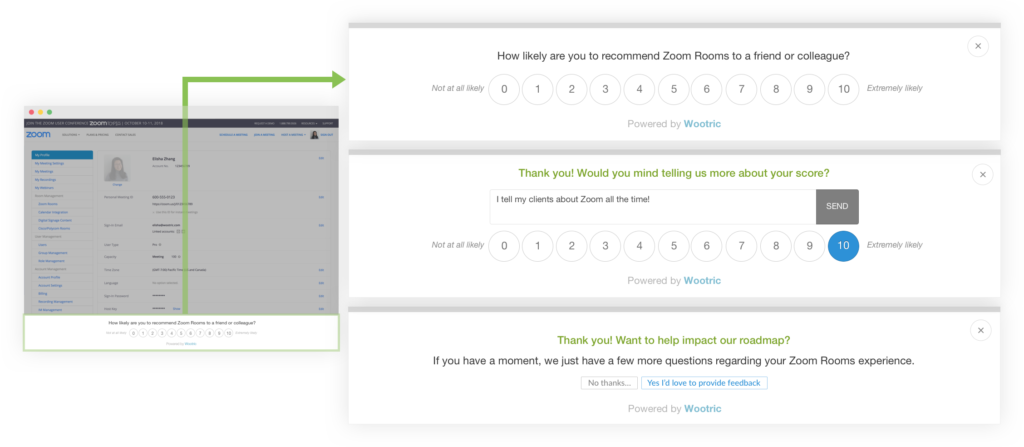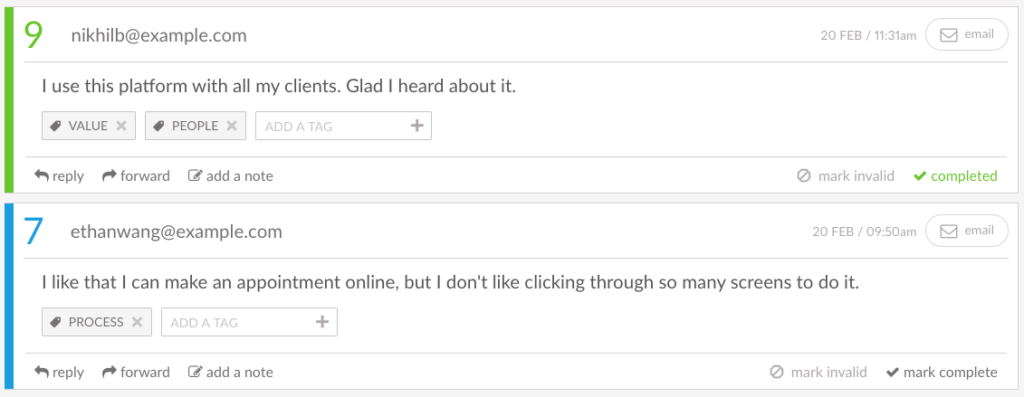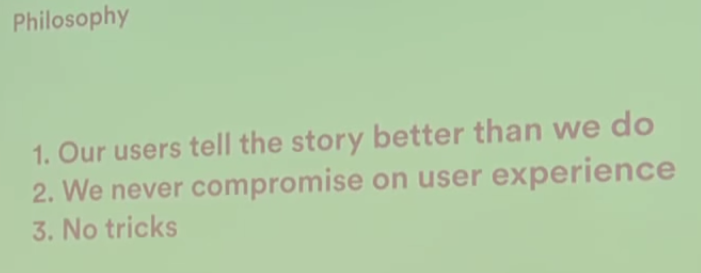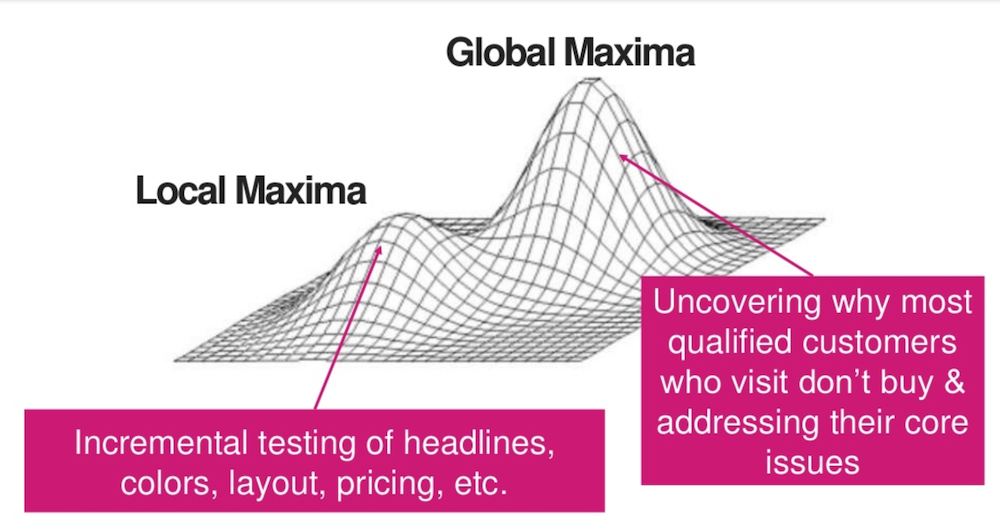10 Things Every SaaS Business Should Know About Net Promoter Score
So you’ve been reading up on Net Promoter Score. Your colleagues in the SaaS world tell you that it’s the best way to take your customers’ pulse. You’ve seen a few case studies claiming it’s the only number you need to measure.
So you’ve been reading up on Net Promoter Score. Your colleagues in the SaaS world tell you that it’s the best way to take your customers’ pulse. You’ve seen a few case studies claiming it’s the only number you need to measure.
It’s true that Net Promoter Score is a great way to engage with your customers and solicit tons of feedback. But it’s also true that there are quite a few nuances that result in a successful survey program.
As a SaaS company with SaaS customers like Zoom, DocuSign and Hubspot, we have a unique perspective on NPS in cloud software. To make the most of your time and energy, we’ve put together this list of things SaaS businesses should know before they dive into the NPS world.
Have questions? Feel free to drop us a line. You can also check out our demo account to get a feel for the platform.
Wait, what is NPS exactly? Read about the concept and the formula.
1. Create user segments for business-critical insight.
Don’t let your NPS data turn into a dusty pile of unused information. It’s a no brainer to segment based on likelihood to recommend (Promoters, Passives, Detractors.) But the real power comes from additional segmentation by metrics that are important to your business.
For example, if you have tiered pricing plans, segment your users based on those plans. One of our SaaS customers has two unique user types — restaurant owners and the wait staff. He discovered that while his overall NPS was strong, there was a discrepancy in score and sentiment between these two distinct user types. This valuable insight helps him balance product development to support both user groups.
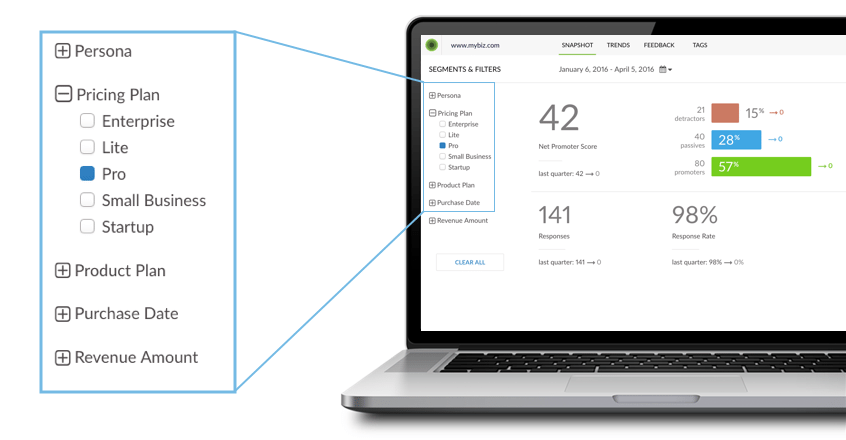
Here’s a look at how you can customize segments in Pearl-Plaza.
By slicing and dicing the data, you’ll be able to identify opportunities for better marketing and potentially predict (and prevent) churn. The New York Times is using similar data to target subscribers who are at a high risk of leaving. The MIT Technology Review is right when they say, “The success of many companies increasingly depends on how wisely they can mine data about their customers’ behavior and respond accordingly.”
Setting up an NPS program? Get the ebook, The Modern Guide to Winning Customers with Net Promoter Score. You’ll learn eight ways SaaS companies are driving growth with a real-time approach to NPS.
2. Ask targeted follow-up questions.
In addition to asking for a numerical rating, you can (and should!) also ask for more information. Simplicity is at the core of NPS philosophy so plan your follow-ups accordingly. Prepare a single automated follow-up question for each group.
Here are some suggestions:
- Promoters: What’s your favorite part about our product/service?
- Passives: What would make you love us?
- Detractors: What could we do to improve your experience?
The follow-up question needs to extract feedback that you can use to turn detractors and passives into promoters, and promoters into referrers. Here is more on how and why to customize the follow-up question.
3. Reach end users. Ask the NPS question inside your product.
SaaS businesses should reach out to their users in the application itself, at the very moment when they’re in the experience—that’s when the message should pop up asking for their feedback. It’s a low-friction way to get vital guidance for the product team.
Here’s a look at a 3-step Wootric survey in Zoom:
Pro tip: If you’re using Intercom, you can deliver an Pearl-Plaza survey within Intercom chat.
That said, email isn’t obsolete. Sending an email NPS survey, when appropriate, can give you vital feedback. For example, if you want to survey someone who just worked with customer support, email makes more sense than an in-app survey—especially if you’ve been discussing their issue via email.
So… how do you decide when to use in-app instead of email surveys? If you want to understand feature experience, use an in-app survey. If your key stakeholders don’t log in often, email is your best bet.
Openview Partners, proponents of product led growth, argue that to build a successful SaaS today, you must solve end user pain. It’s all about ease and productivity. For evidence, they point to DocuSign, Slack, Zoom — end user adoption propelled these B2B SaaS juggernauts to IPO.
Should you ask end users for NPS feedback? You’d be crazy not to.
4. Complement hard data with anecdotal findings.
You’re investing in NPS for more than a score.
At the end of your first survey, you’ll have a single number you can point to but you’ll also have a ton of anecdotal data to internalize. How do you balance the quantitative data and the qualitative data?
Here are our thoughts:
Actions together with emotions are a powerful combo. That gut ‘voice of customer’ reaction complements all the behavioral tracking. And — perhaps more importantly — a ton of insight comes from the open feedback provided along with the NPS score.
The qualitative feedback enhances and helps explain in-product activity (and uncover new sources of satisfaction/dissatisfaction not visible behind the scenes.)
With click data alone, you cannot possibly glean all the valuable nuggets of information buried in customer comments and follow-up emails. SaaS companies love optimization but don’t get carried away. One of the biggest advantages of NPS is unlocking the customer’s voice.
If you are dealing with a lot of qualitative feedback, categorizing using tags can help. When it becomes a firehose, you are ready for text analytics to tell you what your customers are feeling and what they care most about.
5. Use NPS as a referral trigger.
In 2014, Airbnb increased bookings from their referral program by more than 300% per day.
How the heck did they pull that off?
According to Jason Bosinoff, a member of the Airbnb growth team, they stopped asking everyone to refer friends and focused instead on key moments in the customer lifecycle.
Like any good data-driven company, they didn’t make any assumptions about what inspired referrals. Instead, they asked themselves: Is there a correlation between NPS data and customers who actually made referrals? It may seem like a no brainer, since NPS surveys ask people point-blank how likely they are to recommend your product or company. However, people aren’t always the best predictors of their own future behavior, so Airbnb needed to know for sure whether the two metrics were at all correlated.
What they found was that customers who gave them a score of 10 in response to the NPS survey were 4% more likely to pass along a referral. Although that may not seem like much, 4% of 600,000 is 24,000 potential new guests and hosts! There’s a lot of long-term, lifetime value to be generated from 24,000 potential customers.
However, what really matters here is the directionality of the data. When Airbnb took measures to successfully increase NPS, they saw a subsequent increase in referrals.
Net Promoter Score surveys identify promoters who, as the name implies, are potential advocates. When a customer rates your company at nine or 10, it’s the perfect time to ask them to refer friends or write a product review.
Even better, this is an example of the kind of growth marketing we love — it is easy to automate asking for a referral. Using a tool like Pearl-Plaza, you can immediately drive a referral opportunity inside your NPS survey or trigger a follow-up email in tools like Hubspot or Intercom.
6. Commit to ongoing measurement.
Your SaaS product likely changes every week, so biannual survey campaigns won’t provide the in-depth feedback you need to iterate quickly. By building NPS into your app with a tool like Wootric, you can monitor the pulse of your customers on a daily basis.
When should you measure NPS? There are two schools of thought. One school says to ask NPS at regular intervals (every 90 days, annually, etc). The second school says to ask NPS at major milestones in the customer journey (e.g., before free trial expiration, after onboarding, prior to renewal). When we launched our NPS program at Wootric, we started by measuring at regular intervals, but today we measure based on the customer journey.
Ongoing measurement also provides a continuous stream of qualitative feedback, which is key to overcoming the “local maxima.” Startup investor Andrew Chen describes this as the point where quantitative data from A/B testing is so fine-tuned it barely affects your app. Overtesting without qualitative feedback means your progress is slowed by attention to fine details while overlooking bigger problems like product/market fit or a better value proposition.
Source: Rand Fishkin
Chen suggests a balance:
Ultimately, I think you have to combine the above approaches, to make sure you have views of the local maxima as well as potential paths into global maxima. Without both pieces of data, it’s like navigating a mountain range with a map that’s been torn into lots of different pieces.
Ongoing NPS measurement is an ideal way to avoid creating this problem in the first place.
Is NPS the only metric you need? For now, yes.
In time, you will want a deeper understanding of your customer journey, and that will lead to asking questions at additional touchpoints using other CX metrics, such as CSAT or Customer Effort Score. To envision how your program will mature, get the ebook CX FOR EVERY STAGE: How to Scale your Voice of Customer Program from Startup to Enterprise,
7. Failure is an opportunity
A study by the Harvard Business Review found these two incredible statistics:
- 23% of customers who had a positive service interaction told 10 or more people about it
- 48% of customers who had negative experiences told 10 or more others
Unfortunately, customers who have a bad experience are more likely to tell their friends and peers than those who had a good experience.
As you start to measure NPS, you can expect to hear some negative feedback from your customers. And though it’s hard to swallow, it’s actually great for your business.
If you can understand why detractors are unhappy, you can take action to solve the problem. This reduces churn and enhances lifetime customer value. And that’s the very reason why you should follow-up with detractors. You will learn how to improve.
As NPS creator Fred Reichheld writes:
“The goal of the Net Promoter System is not to increase your Net Promoter Score. The goal is to increase the number of customer lives you enrich on a sustainable basis.”
8. Map your NPS against…everything.
Think about your score over time in relation to milestones in your business. You could measure your NPS trends against your product update calendar to see which changes triggered a response in positive or negative feedback. You could do the same thing with marketing campaigns or new customer success hires.
Magoosh, an online test-prep company, uses NPS to guide and influence product updates. They measure trends against their product update calendar to see which changes triggered a response in positive or negative feedback.
For example, when Magoosh tweaked the algorithm with the intention of making the GMAT practice test more accurate, but they worried that the lower scores on practice tests might lower NPS scores among respondents who hadn’t yet taken the real test.
To figure out what would happen, they decided to A/B test two different algorithms for the practice test. Group A received the old algorithm, which tended to produce higher scores. Group B received the newer, harsher (but more accurate) algorithm.
After deploying the two different tests to their respective groups, they learned that scoring lower on practice tests had no negative impact on NPS. Plus, once these students took the real test, they gave Magoosh a higher NPS score.
Naturally, Magoosh updated their practice test based on this information. “Suddenly, NPS had a new use case for us – as a powerful, agile product tool,” according to Peter Poer, Director at Magoosh.
NPS is powerful on its own but is even better when layered on other data. Which leads me to…
9. NPS is a layer, not a silo.
As we’ve already discussed, NPS is a catalyst for feedback. In the SaaS world, this can apply to product, marketing, customer success and support. Because of its value to the entire company, it’s beneficial to think of NPS as a layer rather than a silo. Don’t collect feedback in a vacuum — make it an open, transparent process.
Another benefit of building NPS into the company is the ability to share data. Not everyone in the company communicates with customers on a daily basis, so the feedback can provide context where it might otherwise be missing.
Technical integration is easy with tools like Wootric, which connects to your application through native integrations, as well as Segment, Zapier, and mParticle. Once the data is flowing, you can be more specific about where the feedback goes. For example, at Wootric, we add NPS feedback to customer records in Intercom and Hubspot, send NPS feedback to the product engineers in a Slack channel, and keep the sales team up-to-date in Salesforce.
Eventually, as your program matures, each team will want an NPS analytics dashboard scoped for what they care about. For example, the iOS and Android teams just want to understand feedback from users of their respective applications.
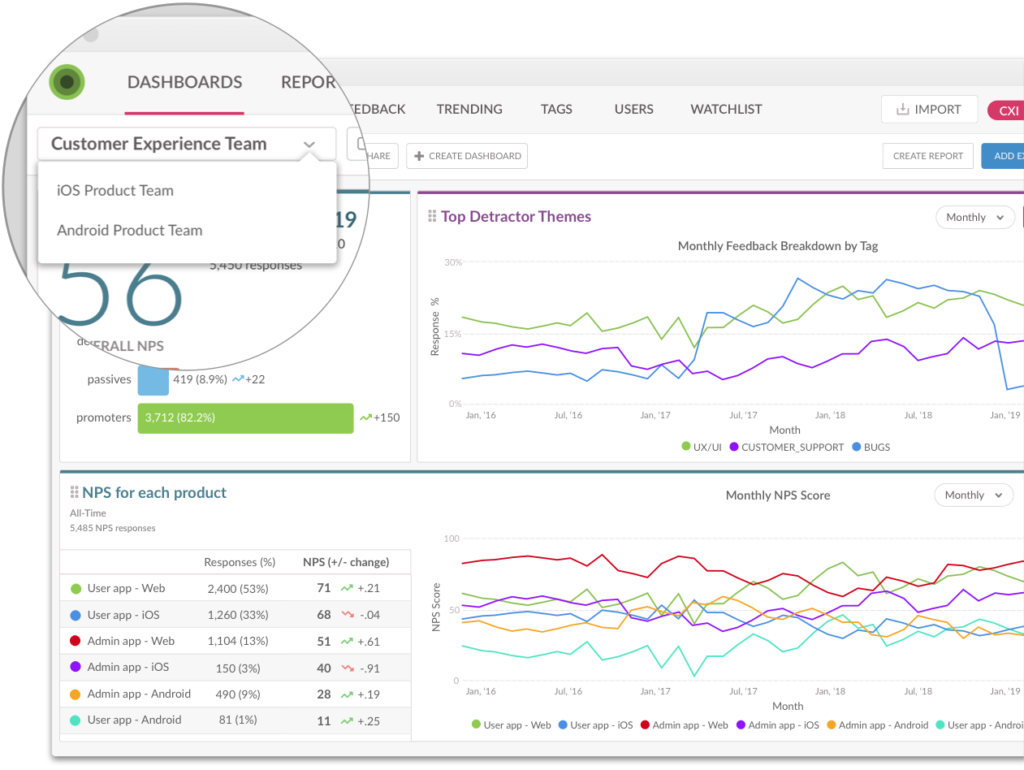
When everything is connected, the feedback loop is tight. And that is what makes the NPS cycle go round.
10. Use NPS to create a customer-centric culture.
Why are some companies so focused on making their customers happy while others treat customers like a nuisance?
Customer-centricity doesn’t happen by accident. It’s sewn into the fabric of a business with 1,000 needles. When customer-centricity permeates an entire business, decisions are easier to make. Instead of wondering how to respond to an angry customer, support reps default to empathy.
A few guiding strategies lead to a series of small moments. The cumulative effect of those moments is a company that develops trust with its customers. And it all comes down to culture.
NPS is just one way to build the voice of your customers into your company. Sending responses into Slack ensures that everyone is thinking about the purpose behind their work. Acknowledging employees who garnered good feedback encourages buy-in from the whole staff. Displaying real-time NPS in the office keeps customer experience top of mind. Discussing NPS in all-hands meetings demonstrates the company’s commitment to the customer.
Lead with action, not words. Your customers and employees will follow.
This updated article was originally published in August, 2015.
If you are planning to explore NPS, you can try Pearl-Plaza for free.
